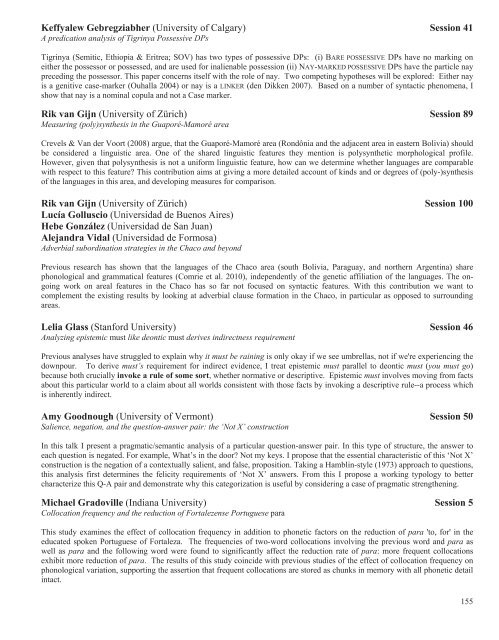here - Linguistic Society of America
here - Linguistic Society of America
here - Linguistic Society of America
You also want an ePaper? Increase the reach of your titles
YUMPU automatically turns print PDFs into web optimized ePapers that Google loves.
Keffyalew Gebregziabher (University <strong>of</strong> Calgary) Session 41A predication analysis <strong>of</strong> Tigrinya Possessive DPsTigrinya (Semitic, Ethiopia & Eritrea; SOV) has two types <strong>of</strong> possessive DPs: (i) BARE POSSESSIVE DPs have no marking oneither the possessor or possessed, and are used for inalienable possession (ii) NAY-MARKED POSSESSIVE DPS have the particle naypreceding the possessor. This paper concerns itself with the role <strong>of</strong> nay. Two competing hypotheses will be explored: Either nayis a genitive case-marker (Ouhalla 2004) or nay is a LINKER (den Dikken 2007). Based on a number <strong>of</strong> syntactic phenomena, Ishow that nay is a nominal copula and not a Case marker.Rik van Gijn (University <strong>of</strong> Zürich) Session 89Measuring (poly)synthesis in the Guaporé-Mamoré areaCrevels & Van der Voort (2008) argue, that the Guaporé-Mamoré area (Rondônia and the adjacent area in eastern Bolivia) shouldbe considered a linguistic area. One <strong>of</strong> the shared linguistic features they mention is polysynthetic morphological pr<strong>of</strong>ile.However, given that polysynthesis is not a uniform linguistic feature, how can we determine whether languages are comparablewith respect to this feature? This contribution aims at giving a more detailed account <strong>of</strong> kinds and or degrees <strong>of</strong> (poly-)synthesis<strong>of</strong> the languages in this area, and developing measures for comparison.Rik van Gijn (University <strong>of</strong> Zürich) Session 100Lucía Golluscio (Universidad de Buenos Aires)Hebe González (Universidad de San Juan)Alejandra Vidal (Universidad de Formosa)Adverbial subordination strategies in the Chaco and beyondPrevious research has shown that the languages <strong>of</strong> the Chaco area (south Bolivia, Paraguay, and northern Argentina) sharephonological and grammatical features (Comrie et al. 2010), independently <strong>of</strong> the genetic affiliation <strong>of</strong> the languages. The ongoingwork on areal features in the Chaco has so far not focused on syntactic features. With this contribution we want tocomplement the existing results by looking at adverbial clause formation in the Chaco, in particular as opposed to surroundingareas.Lelia Glass (Stanford University) Session 46Analyzing epistemic must like deontic must derives indirectness requirementPrevious analyses have struggled to explain why it must be raining is only okay if we see umbrellas, not if we're experiencing thedownpour. To derive must’s requirement for indirect evidence, I treat epistemic must parallel to deontic must (you must go)because both crucially invoke a rule <strong>of</strong> some sort, whether normative or descriptive. Epistemic must involves moving from factsabout this particular world to a claim about all worlds consistent with those facts by invoking a descriptive rule--a process whichis in<strong>here</strong>ntly indirect.Amy Goodnough (University <strong>of</strong> Vermont) Session 50Salience, negation, and the question-answer pair: the ‘Not X’ constructionIn this talk I present a pragmatic/semantic analysis <strong>of</strong> a particular question-answer pair. In this type <strong>of</strong> structure, the answer toeach question is negated. For example, What’s in the door? Not my keys. I propose that the essential characteristic <strong>of</strong> this ‘Not X’construction is the negation <strong>of</strong> a contextually salient, and false, proposition. Taking a Hamblin-style (1973) approach to questions,this analysis first determines the felicity requirements <strong>of</strong> ‘Not X’ answers. From this I propose a working typology to bettercharacterize this Q-A pair and demonstrate why this categorization is useful by considering a case <strong>of</strong> pragmatic strengthening.Michael Gradoville (Indiana University) Session 5Collocation frequency and the reduction <strong>of</strong> Fortalezense Portuguese paraThis study examines the effect <strong>of</strong> collocation frequency in addition to phonetic factors on the reduction <strong>of</strong> para 'to, for' in theeducated spoken Portuguese <strong>of</strong> Fortaleza. The frequencies <strong>of</strong> two-word collocations involving the previous word and para aswell as para and the following word were found to significantly affect the reduction rate <strong>of</strong> para: more frequent collocationsexhibit more reduction <strong>of</strong> para. The results <strong>of</strong> this study coincide with previous studies <strong>of</strong> the effect <strong>of</strong> collocation frequency onphonological variation, supporting the assertion that frequent collocations are stored as chunks in memory with all phonetic detailintact.155
















